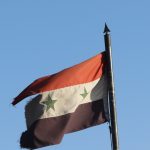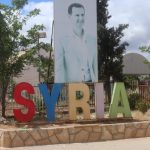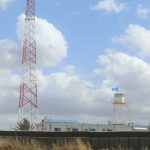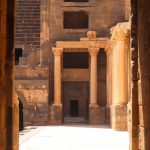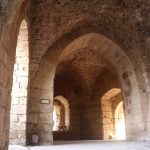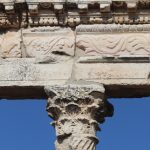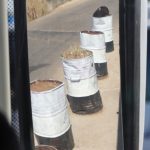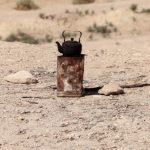The Syria Blog
At the end of 2023 the opportunity arose to travel to Syria with a small group, in June 2024. At the end of 2023 parts of the Middle East were also on fire, with a conflict between Israel and Hamas in Gaza rapidly deteriorating with the potential for further escalation. So when I asked my partner, who usually is also my travel partner, whether she would want to come along, she looked at me in disbelief and called me ‘lunatic’. Taking that as a no, I booked for myself only. No regrets!
But the question is: what do I expect from this trip, ancient ruins or are the more recent ones dominating? What does a country in conflict look like?
01. the Syria idea
I do admit to a certain amount of opportunism. Years ago we planned to go to Syria, only to be denied by what was then euphemistically called the Arab Spring. We all know how that has developed in the past years, and especially in Syria. So when some organisation I know announced a trip to Syria, small group only, I jumped on the opportunity. And where some time ago, for our West African trip, my wife was ultimately the driving force in the decision to go, her reaction this time was less positive. ‘Lunatic’, she called me, and refused to even consider joining.
02. the preparations
The idea to travel to Syria hatched at the end of November 2023, at a time that the conflict in Gaza was still pretty much geographically ‘contained’, if I can use that word. But in the following months the situation became increasingly complex, with Israel attacking the Iranian diplomatic mission in Damascus, Iran firing rockets at Israel and Israel contemplating retaliation, whilst Hezbollah was sort of low-key contributing with its rockets fired from Lebanon, seemingly trying to provoke another Israeli response. Hmm, our trip will start in Beirut, Damascus is obviously on the itinerary, too. I did wait rather a long time with booking my ticket. But then I did, once the situation seemed to calm down somewhat.
03. the past, and especially the recent past
There is a reason, of course, that everybody is so negative about traveling to Syria, and that is to do with its recent history. More about that later. The earliest history of Syria is pretty well known, I suppose. Bordering Mesopotamia, the cradle of our civilization, it has been inhabited for tens of centuries, mostly under the influence of ancient empires, like Egypt and long forgotten powers like the Hittites and the Hurrians, as well as Assyria – not to be confused with present-day Syria, which is an entirely different, unrelated entity.
04. the border
There are no flights to Syria, at least not from any airport near me. Most airlines fly to Beirut – which suited me well, because my Lebanese friend had just returned from Rafa, in Gaza. Yes, that one. After a relaxing day in Beirut the group departure was scheduled early morning from the city centre. And an hour-and-a-half later we arrived at the border.
05. the Golan Heights
The short history of the Golan Heights – and I am sure there are many different versions – is that Syria attacked Israel in 1967, using the Golan Heights as its launch pad. After which Israel hit back, invaded Syria instead, and occupied the Golan Heights. In 1973, during the following war, Syria recovered part of the Golan Heights, but was subsequently pushed back once again by Israeli forces. A cease fire line and a de-facto border was agreed in 1974, leaving 2/3rd of the Golan Heights Israel-controlled, and the eastern 1/3rd administered by Syria.
06. Al Quneitra
The main target today is Al Quneitra, the main town on the Syrian side of the Golan Heights. But first we drive all the way to the end, to the village of Ain Altinah – the end of the Syrian part of the Golan Heights; that is, the Israeli-administered part is across from a 200 meter wide, apparently heavily mined zone, bordered by some major fences. This situation is the result of the various wars between Syria and Israel, in 1967, when Israel occupied a very large part of the Golan Heights, and 1974, after which Israel withdraw from a portion of its occupied area and Syria got part of it back.
07. Bosra
My guidebook, from 2010, calls Bosra the second-best preserved Roman city, after Palmyra. ISIS has seen to it that it is now the best preserved Roman city. With as absolute highlight its Roman theatre.
08. Ma’loula
Obviously the population of Syria is predominantly Muslim – sporting Sunnis and Shiites -, but before the civil war that started in 2011 a significant share, perhaps 10% or more, was Christian. Now that percentage is estimated at around 2-2.5% only, and things are not being made easier by the multitude of Christian denominations, with allegiance to both Roman Catholic and Orthodox churches. Although most Christians live in the big cities, there is an area just north of Damascus where they dominate in the villages.
09. Krak des Chevaliers
All along the road there are small stalls, often no more than a table, with some large plastic bottles. These sell fuel. Of course there are normal service stations, although I don’t see that many, but these are avoided my most motorists. The way it works – or so I have been explained – is the Syrian government buys oil from the Kurds, in Northern Syria, at market prices, and refines it into petrol and diesel. It provides some of this for the local market at highly subsidised prices, less than 1 US$ a litre. But this is expensive, so they limit the supply.
read more (we will get to the castle)
10. the factory
Even Syria produces wine, and why not? Lebanon does, quite nicely, and after all some 10 percent of the Syrian population used to be Christian. Besides, quite a few of the Muslims don’t seem to have a problem with drinking alcohol here, either. We visit the Kefraya winery (in order not to be confused with its namesake in Lebanon, the wine is actually called Kafraya), which produces just three varieties, it seems: red, white and rose.
11. the road to Aleppo
Only a few days ago we drove through Quneitra, seeing the remains of the damage done by the Israeli army 50 years ago on display. The Syrian government had decided to leave this as it is, as a reminder of the savage tactics of the Israelis. But what about the road to Aleppo?
12. Aleppo
Aleppo used to be the commercial capital and the biggest city of Syria, bigger than Damascus. My guidebook, from 2010: ‘In Aleppo 80% of its old monuments inside the walls have survived’ and ‘in the winding lanes of the souk you will come closer to experiencing a medieval city centre than anywhere else in the Arab world’. But that was before the war.
13. Apamea and the mosaics museum
The world famous Mosaics Museum, with more than 2000 m2 of some of the finest, most complete Roman and Byzantine mosaics, is housed in an old caravanserai in Ma’arat al-Numan, some 80 km south of Aleppo. And Ma’arat al-Numan has been in the firing line of the Syrian civil war for many years. To get to the museum, we drive, once again, through rubble, and more rubble, not a single house is standing undamaged.
14. Hama
We have got a hour or two in Hama. If you think internal violence in Syria is a recent development, think twice: Hama rose to fame in 1982, when the Muslim Brotherhood, which had a strong following in conservative Hama, staged an uprising against the regime of Assad-pére. It took three weeks, heavy bombardments by the army’s tanks, and somewhere between 10,000 and 25,000 dead, but then it was over again.
15. Homs
The entry into Homs is humbling. I have seen ruins before, last in and around Aleppo, but the destruction of the outskirts of Homs is beyond comparison. Everything has been shot up, houses collapsed, burned out. This compares badly to the effects of the Indian Ocean tsunami of 2004 or the Haiti earthquake in 2010, the results of which I both witnessed. And those were natural disasters, this is what men did against each other.
16. Palmyra
So far we have been moving generally north-south or south-north, in the area where the vast majority of the population lives. For Palmyra we turn east, into the desert. For a short while the road is still lined with olive groves, and with other trees, although many of these have been reduced to stumps. But soon the trees disappear, too, and the herds of sheep get less, and smaller. Houses, too, disappear, and are being replaced, locally by some type of bee-hive hut, and by tents.
17. Damascus
At the end of our trip we finally spend time in Damascus. Less than 48 hours, by far not enough, of course, but we do get to wander around. Thankfully, although the outskirts of town also show quite some war damage, the centre, especially the Old Town, has been spared the ravage we have seen in so many other Syrian cities.
18. Damascus (2)
After the Great Umayyad Mosque and the souk, the highlights of Damscus and the sites we visited first, we also had some time for the rest of the Old City.
19. what to make of ten days in Syria?
Firstly, contrary to common belief, traveling in Syria is not dangerous. There has not been a single moment that I have felt uncomfortable, let alone threatened. I suppose it has been relatively quiet in Syria for the past four, five years, fighting has subdued, the government is in control again of most of the country – and those are the only places we can travel anyhow.
20. another word on group travel
I know I have been very critical about group travel, not my thing, etcetera. Earlier experiences were not necessarily a great success altogether. But for a trip to Syria, once again because of the uncertainties ahead of the trip, I had selected group travel once more.











